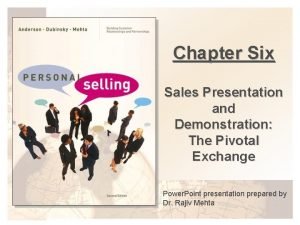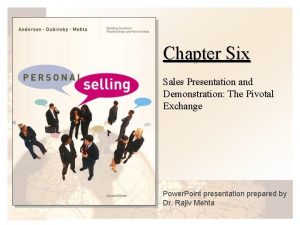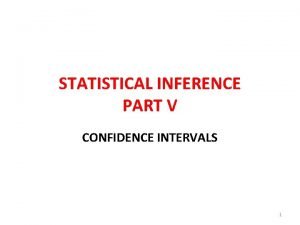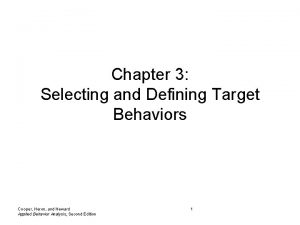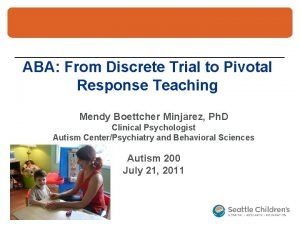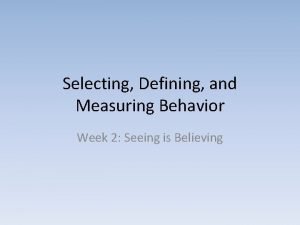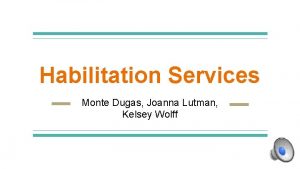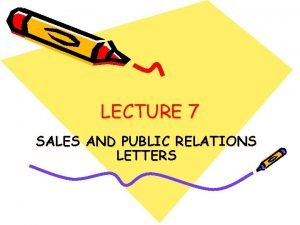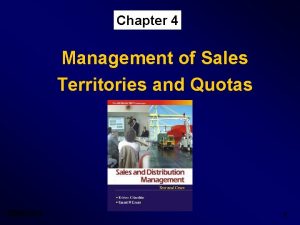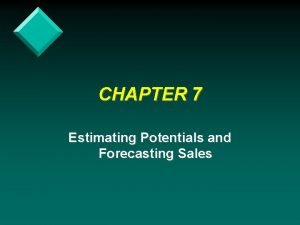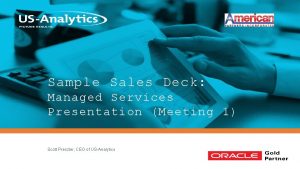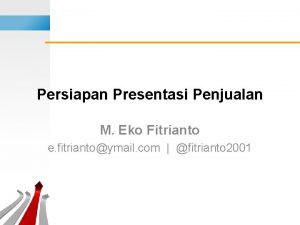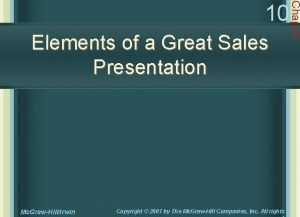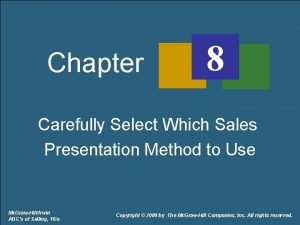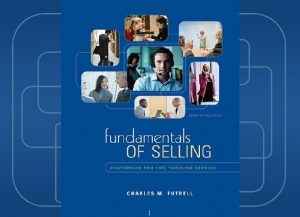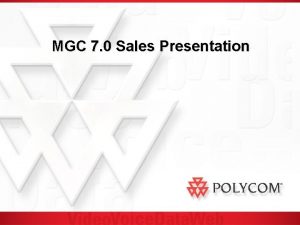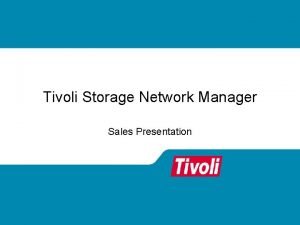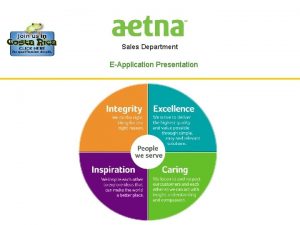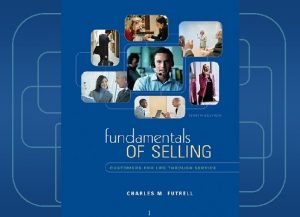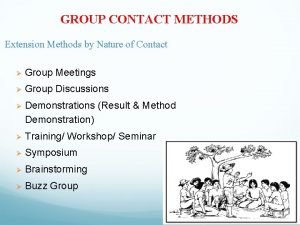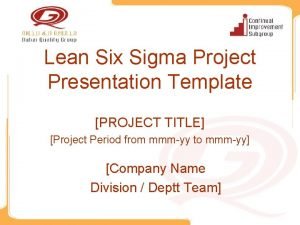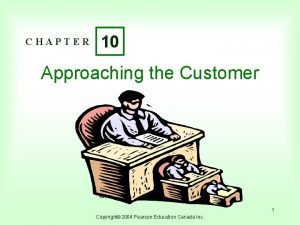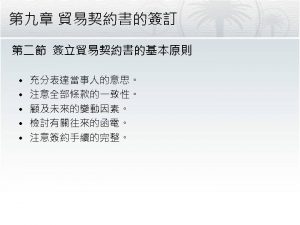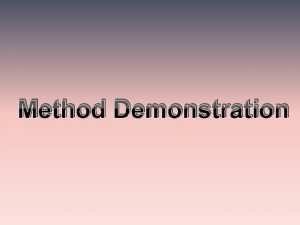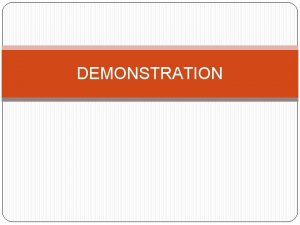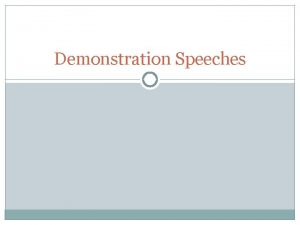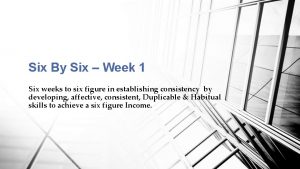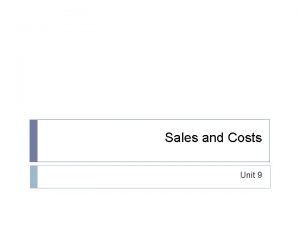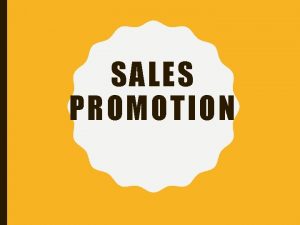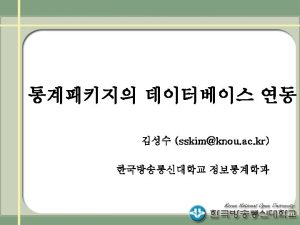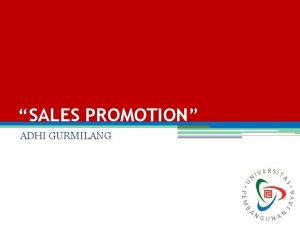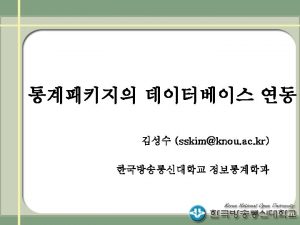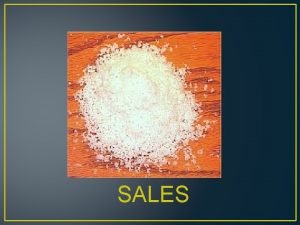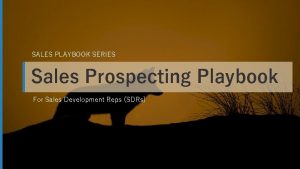Chapter Six Sales Presentation and Demonstration The Pivotal





































- Slides: 37

Chapter Six Sales Presentation and Demonstration: The Pivotal Exchange Power. Point presentation prepared by Dr. Rajiv Mehta

Learning Objectives After reading this chapter, you should understand • Alternative sales presentation strategies. • Guidelines for effective sales presentations and demonstrations to organizational prospects. • Preparation of written sales presentations. • Sales presentation strategies for different prospect categories. • Use of adaptive and canned sales presentations. • Sales presentations to prospect groups. Royalty-Free, Digital Vision/Getty Images • How to make a sales presentation memorable. Copyright © Houghton Mifflin Company. All rights reserved. Chapter 6 | Slide 2

Success Factors for Professional Salespeople • The top ten success factors in selling: • Listening skills • Follow-up skills • Ability to adapt sales style from situation to situation • Tenacity – sticking to the task • Organizational skills • Verbal communication skills • Proficiency in interacting with people at all levels within an organization • Demonstrated ability to overcome objections • Closing skills • Personal planning and time management skills

The First Sales Call and the Sales Presentation • Successful salespeople think of the sales presentation and demonstration as the pivotal exchange between seller and buyer in the sequence of exchanges that make up the selling process • The approach emphasized in this text is the consultative problem-solving strategy Copyright © Houghton Mifflin Company. All rights reserved. Chapter 6 | Slide 4

The Strategic/Consultative Selling Model Evolved in response to: • Increased competition • More complex products • More emphasis on customer needs • Long-term relationships © 2015 by Pearson Education

2. Identifying the Prospect’s Problems and Needs Royalty-Free, Digital Vision/Getty Images Copyright © Houghton Mifflin Company. All rights reserved. • Using a consultative, problem-solving approach, the professional salesperson tries to uncover the prospect’s perceived problems and needs through skillful questioning and careful listening. Chapter 6 | Slide 6

Planning the Sales Presentation • To prepare for the first sales presentation, salespeople can think of 5 planning stages: 1. Gathering information 2. Identifying the prospect’s problems and needs 3. Preparing and presenting the sales proposal 4. Confirming the sale and/or the relationship 5. Ensuring customer satisfaction Chapter Review Question: What are the basic steps in planning the sales presentation? Copyright © Houghton Mifflin Company. All rights reserved. Chapter 6 | Slide 7

1. Gathering Information gathering must start before customer visit. Customer specific info should be collected before the sales presentation. - Google the Company/ examine the web site - Google the Prospect - Linked. In: Experience at their current job –Experience at their former jobs, Shared connections, Groups, Recent activity - Buyer’s Twitter Account - Company’s Press and Media Releases Page - Competitors’ Press and Media Releases Pages - Financial Statements - Blogs - Facebook Copyright © Houghton Mifflin Company. All rights reserved. Chapter 6 | Slide 8

2. Identifying the Prospect’s Needs • Too much talk can be detrimental to the sales process. A chronic complaint is that salespeople talk too much, fail to ask the right questions, and do not really listen to the buyer. • Top-performing salespeople understand the need to gather all the relevant information they can about prospects and their perceived problems. Copyright © Houghton Mifflin Company. All rights reserved. Chapter 6 | Slide 9

2. Identifying the Prospect’s Needs • First, make sure you’re talking to decisionmakers (those with authority to buy) or key influencers, so neither party’s time is wasted. • Next, ask probing questions to encourage prospects to provide information on perceived problems, objectives, financial issues, needs, and personal feelings Copyright © Houghton Mifflin Company. All rights reserved. Chapter 6 | Slide 10

3. Preparing and Presenting the Sales Proposal • Before making a sales presentation, take the time and effort to prepare yourself to give a superb performance. • Thus, remember the following: A. Professional approach to sales presentations Royalty-Free, Digital Vision/Getty Images B. FAB C. Value-added selling (VAS) Royalty-Free, Digital Vision/Getty Images Copyright © Houghton Mifflin Company. All rights reserved. Chapter 6 | Slide 11

3. Preparing and Presenting the Sales Proposal A. Professional approach to sales presentations • Salespeople should custom-tailor the sales presentation and demonstration to the prospect’s specific business situation, needs, and individual communication style. • The sales presentation strategy can vary depending on different types of prospects Copyright © Houghton Mifflin Company. All rights reserved. Chapter 6 | Slide 12

3. Preparing and Presenting the Sales Proposal B. FAB leads to SELLS F —Features are the obvious characteristics of the A B product. —Advantages are the performance traits of the product that show it can be used to help the customer better solve a problem than present products can. —Benefits are what the customer wants from the product. Copyright © Houghton Mifflin Company. All rights reserved. S —Show the product’s features. E —Explain its advantages. L —Lead into the benefits for the prospect. L —Let the prospect talk. S —Start a trial close. Chapter 6 | Slide 13

3. Preparing and Presenting the Sales Proposal C. Value-added selling (VAS) • A comprehensive strategy, VAS focuses on providing customers with extra, or value-added benefits over those offered by competitors • VAS shows customers that the extra overall perceived value is greater than that the competitors are offering • VAS presentations go beyond the FAB approach to convincingly present and demonstrate the overall added value (benefits) that the customer will receive from purchasing from their company across four categories: 1. 2. 3. 4. Value-added product benefits Value-added relationship benefits Value-added company benefits Value-added salesperson benefits Copyright © Houghton Mifflin Company. All rights reserved. Chapter Review Question: What is the value-added selling approach to sales presentations? Identify and discuss the four value dimensions. Chapter 6 | Slide 14

Table 6. 3 Value-Added Benefit Comparison Chart Copyright © Houghton Mifflin Company. All rights reserved. Chapter 6 | Slide 15

4. Confirming the Sale and/or the Relationship Professional salespersons: • See their prospects and customers as business partners cultivating a relationship based on trust, mutual interests, and cooperation, instead of aggressively on “closing the sale. ” • Spend considerable time trying to undercover and fully understand the needs and concerns of their partners through attentive listening and by serving as trusted advisers, consultants, and even friends. • Do not want to sell products or services with which the customer will not be satisfied. • Realize that only by providing continuous customer satisfaction will they obtain the repeat business that leads to long-term customer loyalty and higher commissions for themselves and greater profits for their companies. Copyright © Houghton Mifflin Company. All rights reserved. Chapter 6 | Slide 16

5. Building Relationships and Achieving Customer Satisfaction • Some underperforming salespeople neglect post-purchase customer service. Immediately after the sale, their interest, contact, and relationship with the customer fall off rapidly. • Such shortsightedness or indifference is a “relationship killer, ” and these salespeople may later have to work doubly hard to reestablish rapport and rebuild the relationship with that customer. • High performing salespeople are committed to providing prospects and customers with totally satisfying service throughout the long-run relationship—before, during, and after the sale. • They understand that fully satisfying current customers generates repeat sales, referrals to other prospects, and increased sales as customer needs grow. Copyright © Houghton Mifflin Company. All rights reserved. Chapter 6 | Slide 17

General Guidelines for Effective Sales Presentations cont’d • Prospects want to understand a product with all their senses, so where appropriate in the demonstration help prospects see, hear, feel, smell, and taste a product. • Eight planning steps to prepare for the demonstration are: 1. Demonstrate benefits that are custom-tailored to the prospect's needs 2. Decide what to say about the benefits from the prospect's perspective Royalty-Free, Digital Vision/Getty Images 3. Select sales aids that involve the most human senses and will make the most positive impact Copyright © Houghton Mifflin Company. All rights reserved. Chapter 6 | Slide 18

General Guidelines for Effective Sales Presentations cont’d 4. Pre-check all sales aids to make sure everything is working smoothly 5. Decide when and where to make the demonstration (usually a controlled environment is best) 6. Involve the prospect in the demonstration. Remember the motto: "If they try it, they'll buy it” 7. Prepare a written demonstration outlining three columns: • Benefit to demonstrate • What to say • What to do 8. Rehearse the demonstration many times until you have the right timing of actions and words Royalty-Free, Digital Vision/Getty Images Copyright © Houghton Mifflin Company. All rights reserved. Chapter 6 | Slide 19

General Guidelines for Effective Sales Presentations cont’d Dressing for Success An important part of any sales presentation is the salesperson's personal appearance Royalty-Free, Digital Vision/Getty Images Copyright © Houghton Mifflin Company. All rights reserved. Chapter 6 | Slide 20

Table 6. 4 Dressing for Sales Presentation Success Copyright © Houghton Mifflin Company. All rights reserved. Chapter 6 | Slide 21

How to dress Dress like your customer keep your dress in tune with the customer and part of the country you're in Stay neat - do a quick mirror check in the restroom before a meeting to make sure you look presentable - shoes have to be polished - If you are a woman, do not wear very low-cut clothes Beware of offensive odors Don't smoke Copyright © Houghton Mifflin Company. All rights reserved. Chapter 6 | Slide 22

Chapter 6 | Slide 23

Chapter 6 | Slide 24

Copyright © Houghton Mifflin Company. All rights reserved. Chapter 6 | Slide 25

Copyright © Houghton Mifflin Company. All rights reserved. Chapter 6 | Slide 26

Effective Behavior and Listening Principles • Look like a successful /well organized salesperson • Develop rapport early • Adjust to the customer's communication style • Present the strongest customer benefits and selling points first • Establish credibility • Make the presentation fun • Arouse as many of the customer's five senses as possible • Combine factual and emotional appeals Copyright © Houghton Mifflin Company. All rights reserved. Chapter 6 | Slide 27

Effective Behavior and Listening Principles • Look for and use responsive behaviors • Help prospects draw the right conclusions • Avoid making puns/jokes • Never tell ethnic or offensive jokes • Never disparage another company or individual • Help prospects draw the right conclusions • Use humor with discretion and only when appropriate • Readily admit minor product weaknesses Copyright © Houghton Mifflin Company. All rights reserved. Chapter 6 | Slide 28

General Guidelines for Effective Sales Presentations: Listening Principles • Salespeople must act professionally and listen reactively to their prospects © Royalty-Free/CORBIS • The old maxim “The reason you have two ears and one mouth is that you should listen twice as much as you talk” is especially true for a salesperson Copyright © Houghton Mifflin Company. All rights reserved. Chapter 6 | Slide 29

Table 6. 6 Keys to Good Listening Copyright © Houghton Mifflin Company. All rights reserved. Chapter 6 | Slide 30

Table 6. 6 Keys to Good Listening cont’d Copyright © Houghton Mifflin Company. All rights reserved. Chapter 6 | Slide 31

Selling the Long-term Relationship • As many industries seek to improve quality and reduce costs, the trend toward closer supplier relationships, longerterm contracts, and fewer suppliers is increasing • Salespeople must go beyond mere “selling” to “serving” their customers much like consultants or business partners • What these trends tell selling organizations is that selling the long-term relationship is not just another strategy, it is fast becoming the only viable strategy Copyright © Houghton Mifflin Company. All rights reserved. Chapter 6 | Slide 32

Chapter Review Questions 1. Why are the sales presentation and demonstration so important in the Personal Selling Process? 2. Why are clothing and accessories important considerations in making an effective sales presentation? Copyright © Houghton Mifflin Company. All rights reserved. Chapter 6 | Slide 33

Topics for Thought and Class Discussion 1. Why do you think the consultative problem-solving sales presentation is the most successful strategy for professional salespeople? What are the benefits of this strategy to the prospect or customer? 2. Name at least five special prospect categories, and describe an appropriate strategy for a sales presentation to each. 3. Which do you think is more effective for most business-tobusiness selling, an oral or a written sales presentation? Why? 4. Do you think sales presentations and demonstrations are more important for tangible products or for intangible services? Why? Copyright © Houghton Mifflin Company. All rights reserved. Chapter 6 | Slide 34

Internet Exercises 1. Using an Internet search engine, find three firms that specialize in sales presentation training, and visit their websites to determine whether they use other types of sales presentation strategies in addition to those identified and described in this chapter. 2. Use Google or any other search engine to locate two examples of sales presentation strategies being demonstrated using Flash or streaming video. Copyright © Houghton Mifflin Company. All rights reserved. Chapter 6 | Slide 35

Projects for Personal Growth 1. Contact two business-to-business salespeople and ask them about their methods of preparing sales presentations, dress style during the presentation, and demonstration techniques. 2. Research the following two industries and report on the methods and approaches that each uses to sell its products: (a) airplane manufacturers, and (b) manufacturers of household products. 3. Contact three salespeople (one who sells to manufacturers, one who sells to resellers, and one who sells to the national government) and ask them how they prepare for their sales presentations and demonstrations. Are there major differences? What similarities emerged? Copyright © Houghton Mifflin Company. All rights reserved. Chapter 6 | Slide 36

Projects for Personal Growth cont’d 4. With a classmate, take turns playing the role of a publishing company sales rep trying to sell a new textbook to a college professor who might be nicknamed “Skeptical Sid. ” Then prepare a written sales presentation to sell a textbook to the instructor of your personal selling class. Depending on how creative or cooperative your instructor is, you may want to ask him or her to play one of the prospect stereotypes described in Table 6. 2. 5. Assume that you are a sales representative for a manufacturer of automatic fire sprinkler systems for commercial buildings. Outline sales presentations using each of the seven basic strategies. For each strategy, create and then describe the individual prospect or group of prospects to whom you’re presenting. Copyright © Houghton Mifflin Company. All rights reserved. Chapter 6 | Slide 37
 Sales presentation and demonstration
Sales presentation and demonstration Presentation and demonstration
Presentation and demonstration Pivot confidence interval
Pivot confidence interval Definition of target behavior
Definition of target behavior Discrete trial training
Discrete trial training Pivotal merchant services
Pivotal merchant services Primary tricuspid regurgitation
Primary tricuspid regurgitation Frequency behavior data sheet
Frequency behavior data sheet Pivotal position
Pivotal position Kelsi monteo
Kelsi monteo Pivotal prayer
Pivotal prayer Sales organization structures
Sales organization structures Discuss the nuances of sales letters.
Discuss the nuances of sales letters. Sales department structure
Sales department structure Clover leaf routing plan
Clover leaf routing plan Classify each polygon
Classify each polygon Sales force composite
Sales force composite Diameters of fetal head
Diameters of fetal head Leopold maneuver
Leopold maneuver Managed services proposal ppt
Managed services proposal ppt Retail sales presentation
Retail sales presentation Teknik canned sales presentation adalah
Teknik canned sales presentation adalah Types of sales presentation
Types of sales presentation Sales presentation ideas
Sales presentation ideas Sales presentation method
Sales presentation method Structure of sales presentation
Structure of sales presentation Mgckey
Mgckey Sales pitch agenda
Sales pitch agenda Medicare supplement sales presentation
Medicare supplement sales presentation Sales presentation mix
Sales presentation mix Consultative sales presentation guide
Consultative sales presentation guide Sales presentation methods
Sales presentation methods Advantages and disadvantages of individual contact method
Advantages and disadvantages of individual contact method Six sigma project presentation
Six sigma project presentation Six step presentation plan
Six step presentation plan Hát kết hợp bộ gõ cơ thể
Hát kết hợp bộ gõ cơ thể Lp html
Lp html Bổ thể
Bổ thể
